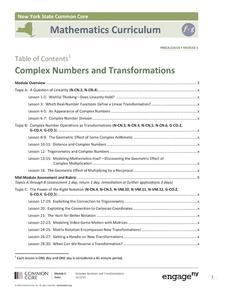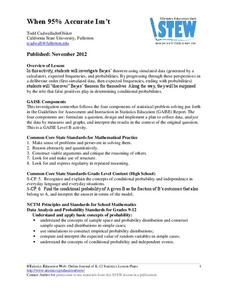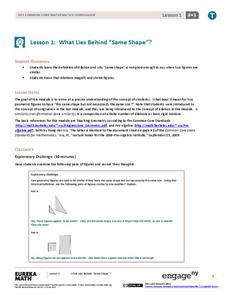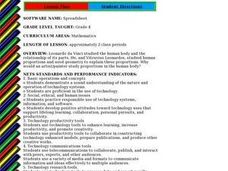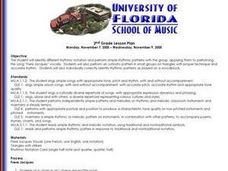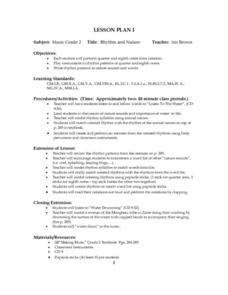EngageNY
Complex Numbers and Transformations
Your learners combine their knowledge of real and imaginary numbers and matrices in an activity containing thirty lessons, two assessments (mid-module and end module), and their corresponding rubrics. Centered on complex numbers and...
Science Geek
Valence Electrons
There is a lot of negativity when studying electrons, but this presentation makes the experience more positive by beginning with the definition of a valence electron and breaking down the number of valence electrons by groups on the...
EngageNY
Vectors in the Coordinate Plane
Examine the meaning and purpose of vectors. Use the lesson to teach your classes how find the magnitude of a vector and what it represents graphically. Your pupils will also combine vectors to find a resultant vector and interpret its...
EngageNY
Representing Reflections with Transformations
In the 16th lesson in the series of 32 the class uses the concept of complex multiplication to build a transformation in order to reflect across a given line in the complex plane. The lesson breaks the process of reflecting across a line...
Statistics Education Web
When 95% Accurate Isn’t
Investigate the effect of false positives on probability calculation with an activity that asks scholars to collect simulated data generated by a calculator. To finish, participants analyze the probability of certain outcomes which lead...
EngageNY
What Lies Behind “Same Shape”?
Develop a more precise definition of similar. The lesson begins with an informal definition of similar figures and develops the need to be more precise. The class learns about dilations and uses that knowledge to arrive at a...
Statistics Education Web
Who Sends the Most Text Messages?
The way you use statistics can tell different stories about the same set of data. Here, learners use sets of data to determine which person sends the most text messages. They use random sampling to collect their data and calculate a...
EngageNY
Mid-Module Assessment Task: Grade 6 Math Module 4
Halfway through the module — the perfect time for an assessment. The 18th installment of a 36-part series is a mid-module assessment. Scholars provide evidence of understanding through various mathematical and contextual problems.
EngageNY
Grade 5 Math Module 1: End-of-Module Assessment
The last installment of the 18-part Grade 5 Math Module 1 is an end-of-module assessment. Scholars answer questions that require explaining the connection between powers of 10 and place value, rewriting decimals in different forms,...
West Contra Costa Unified School District
Congruence Through Transformations
Transform your lesson on transformations. Learners use given congruent triangles and tracing paper to determine the single transformation that carries one to the other. The concept is extended to combinations of transformations to...
Illustrative Mathematics
Latitude
The greater the latitude, the less of the Earth is north. Scholars graph the relationship between the latitude and the percentage of the Earth that is north of the latitude. Using the graph and the table, class members interpret values...
Curated OER
Rhythm Counting
Students perform various rhythms and melodies in unison on their individual instruments. Assessment is performed on the last day of the lesson with each student playing individually for the class. This lesson meets national standards...
Curated OER
Body Proportion
Fourth graders measure the height and arm span of various classmates. They use a spreadsheet to design a graph that shows the class measurements from tallest to shortest in metric and standard systems.
Curated OER
Worksheet Chapter 5 College Prep Algebra
In this algebra worksheet, students evaluate algebraic expressions, simplify exponents, write numbers in scientific notation, perform division of equations, and find the area of given problems. This worksheet contains 75 problems and an...
Curated OER
A Fashion Extravaganza
Students decide what body measurements they need to make garments such as a pair of pants. They make a list, and work with a partner to take and record those measurements in centimeters. They discuss the use of centimeters.
Curated OER
Exponential Problems
In this algebra worksheet, students solve exponential problems by rewriting it in standard form. They rewrite number using scientific notations and solve word problems. There are 10 problems with and answer key.
Curated OER
Frere Jacgues
Second graders identify different rhythmic notation and perform simple rhythmic patterns with the group, applying them to performing the song "Frere Jacques" vocally. Emphasis is placed on meeting State and National Standards for the Arts.
Curated OER
Broccoli
Students compose, notate, and evaluate their own rhythmic compositions using the song "Broccoli" for inspiration in this excellent elementary-level General Music lesson. Emphasis is placed upon four-measure patterns and the classic...
Curated OER
Rhythm and Nature
Second graders listen to song "Listen to the Water," discuss nature sounds and importance of water to life, perform quarter and eighth notes from notation, play instruments in rhythm patterns of quarter and eighth notes, and write rhythm...
Curated OER
ABBA - Lesson 2
Students identify and notate the musical device known as a "hook". They notate and perform rhythmic and melodic patterns in the ABBA song "Mamma Mia".
Curated OER
Music Elements For Second Grade
Second graders are exposed to a variety of attributes of melody in seven lessons of this unit. the notation in treble clef, pitch, and the movements of the melody are presented in these lessons.
Curated OER
Melodia Sight-Singing
Students practice sight-singing skills in this Choral lesson plan for the High School mixed-choir. Emphasis is placed on State and National Standards in the Arts and the song "Dirait-on", a piece by Morten Lauridson, based on the French...
Curated OER
Place Value: Ones, Tens and Hundreds
In this place value instructional activity, students write numbers in two ways other than that given; students choose from standard form, expanded form and word form.
Curated OER
Students use fundamental counting principle to compute combinations and permutations
Students define Pascal's triangle and special notations used to represent nth elements. In this geometry lesson, students solve problems using permutations and combinations. They compare the formula for permutation to that of Pascal's...
